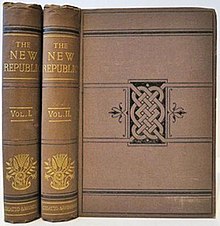The New Republic (novel)
 First editions | |
| Author | William Hurrell Mallock |
|---|---|
| Language | English |
| Genre | satire |
| Publisher | Chatto and Windus |
Publication date | 1877 |
| Publication place | United Kingdom |
The New Republic or Culture, Faith and Philosophy in an English Country House by English author William Hurrell Mallock (1849–1923) is a novel first published by Chatto and Windus of London in 1877. The work had its genesis as a serialization. In June–December 1876 it appeared as a series of sketches in Belgravia magazine.
Plot introduction
The novel is a satire consisting almost entirely of dialogue and mocking most of the important figures then at Oxford University, with regards to aestheticism and Hellenism.
Characters
The famous people Mallock depicts are as follows, together with the names of the characters that represent them.
- Matthew Arnold — Mr. Luke[1]
- Thomas Carlyle — Donald Gordon[1]
- William Kingdon Clifford — Mr. Saunders
- Violet Fane — Mrs. Sinclair [1]
- William Money Hardinge — Robert Leslie[1]
- Thomas Huxley — Mr. Storks[1]
- Benjamin Jowett — Dr. Jenkinson[1]
- W. H. Mallock — Otho Laurence
- Walter Pater — Mr. Rose[1]
- Edward Bouverie Pusey — Dr. Seydon[1]
- John Ruskin — Mr. Herbert[1]
- John Tyndall — Mr. Stockton[1]
Literary significance and criticism
The book became a best seller in its time and retains much of its humour and satirical bite today. As author David Daiches wrote in 1951, "If we can read through The New Republic without at one point or another being made to feel a little foolish, we are wise indeed."
Walter Pater is of particular interest because Mallock's apparent homophobia against him—expressed first in the more extensive treatment given the Mr. Rose character in the initial serialization—helped ruin Pater's public reputation as well as his career at Oxford. Reading Wilde, Querying Spaces: An Exhibition Commemorating the 100th Anniversary of the Trials of Oscar Wilde notes that, as Linda Dowling has observed, "Mr. Rose" is "the first in a long line of popular depictions of effeminate English aesthetes such as Gilbert's Bunthorne and Du Maurier's Postlewaite and Maudle".[2] This depiction of Pater appeared during the competition for the Oxford Professorship of Poetry and played a role in convincing Pater to remove himself from consideration.
Influence
The New Republic inspired a number of novels in which representative gatherings of intellectuals discuss important issues of the day in a country-house setting, including Goldsworthy Lowes Dickinson's A Modern Symposium (1905), John Buchan's A Lodge in the Wilderness (1906) — set in a multi-millionaire's lodge on the East Kenyan Plateau[3] — and Ronald Knox's Sanctions (1924). Evelyn Waugh, in his Life of Ronald Knox writes that "Mallock's New Republic was an essential book to Ronald, perhaps his favourite work of secular literature outside the Classics."[4] H. G. Wells's satirical novel Boon (1915) is explicitly indebted to The New Republic, even featuring the "villa by the sea" that is the setting for Mallock's novel.[5]
References
- ^ a b c d e f g h i j Brewer, E. Cobham (1909). "New Republic (The)". The Historic Note-book: With an Appendix on Battles. Lippincott. p. 616.
- ^ Wilde at Oxford/Oxford Gone Wilde
- ^ Edwin Lee (2002), "The Vision Splendid"
- ^ Evelyn Waugh (1959), The Life of Ronald Knox. London: Fontana Books, 1962, p. 160
- ^ H. G. Wells (1915), Boon. London: T. Fisher Unwin, pp. 74–83, 87, 89
External links
- Mallock, W. H., The New Republic
- Works by William Hurrell Mallock at Project Gutenberg
 The New Republic public domain audiobook at LibriVox
The New Republic public domain audiobook at LibriVox- Elmer Holmes Bobst Library, New York University, Reading Wilde, Querying Spaces
